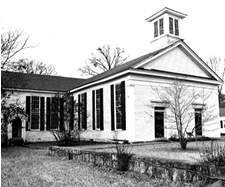|
|
||||||||||
|
|
||||||||||
|
Volume
75
Pitts bequest benefits Candler
The Once and Future Mummy Museum
|
Restoring the Vision
Known today simply as Old Church, the Methodist chapel built in 1841 for Emory students and the Oxford community is set to reopen after a three-year renovation project. Standing five blocks north of Oxford College, the church has never been owned by Emory, but the school’s and church’s histories are closely intertwined. Built five years after Emory College was chartered, the church was presided over by the same Methodist ministers who established and led the fledgling school. Baccalaureate services began at the church in 1843 but were interrupted from 1862 through 1864, when the church was used as an infirmary during the Civil War. In 1878, Emory College President and later Methodist Bishop Atticus G. Haygood orchestrated the addition of wings to either side of the church and the installation of a large, half-moon stage backed by a stained-glass window. Two years later, from that same stage, Haygood delivered a visionary sermon titled "The New South," famed for its progressive views on the region’s race relations and industrial health at the end of the Reconstruction period. A published copy of the speech was later read by New York banker George I. Seney, who responded by giving the college $130,000, which was used to build one of the focal points of the campus, Seney Hall. In 1910, when the Methodist congregation moved to the newly built and much larger Allen Memorial Church, Old Church continued to be used for community events and local Methodist conference meetings. After the establishment of Oxford College as a two-year, associate-degree-granting institution in 1929, the church was once again used for baccalaureate and commencement services. Bishop Warren A. Candler, a former Emory president and chancellor, led a 1932 renovation of Old Church, and in 1949 the North Georgia Conference of the Methodist Church held a formal rededication ceremony. The Methodist conference’s national governing body designated the church as its sixteenth historical shrine in 1972, three years before it was placed on the National Register of Historic Places. The church was built as a simple, one-story white clapboard structure in the Greek Revival style. Fourteen rows of stark, wooden pews provided seating for parishioners, who entered through two front doors, one for men, the other for women. Historians believe the church’s main balcony was added during the slavery era to create segregated seating. Perpendicular to the balcony are two box seats, each large enough to accommodate about eight people. A set of narrow stairs leads to one box, but in what has become an enduring mystery of Old Church, no physical signs of access to the other box exist. "We’re not sure what the answer is," says Jack Pyburn, an Atlanta architect who participated in the restoration. "We haven’t found any evidence of an access or any records talking about it." By the early 1990s, the church began showing its age. The gradual shifting of its rock foundation caused one wall to bulge, pulling pews loose and causing several of the eighteen-foot-tall windows to tilt. The church was closed in 1996. The current renovation was undertaken by the Oxford Historical Shrine Society, which received the building’s deed from the City of Oxford in 1974. "Our vision is to make the church available once again for community activities," shrine president John E. Forney says. Oxford College Dean William H. Murdy has a similar vision. "We’re planning to continue our baccalaureate services in Old Church," Murdy says. "I think it is one of the very significant buildings in the state, and being able to actively use it is one of its great assets." —G.F. |
|||||||||||||||
